#Its Like A 17th Century Painting
Text
I think a lot about this painting that was, presumably, given to Fernando at the 2012 Japanese Grand Prix, which there is just zero explanation for it, other than these pics:

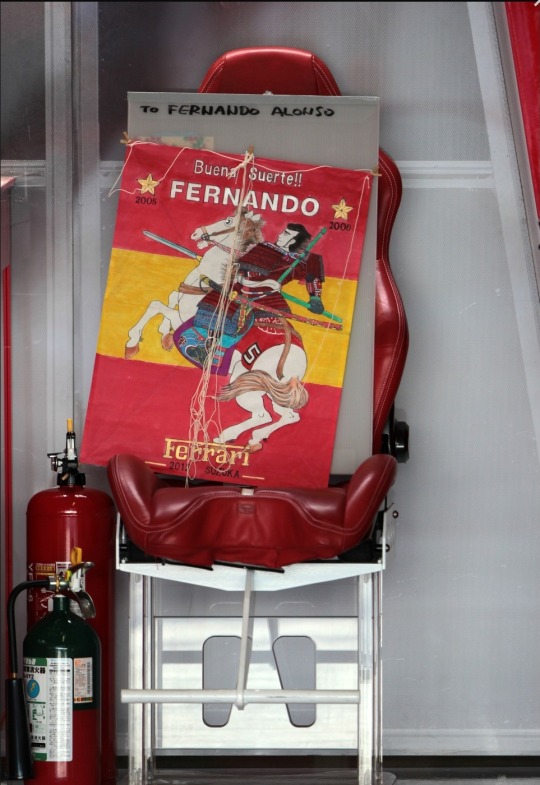

Where is it now????? It better be hanging up in a place of honor in one of his houses istg!
But what makes this better is that after he crashed out from that race, he tweeted a samurai quote 😭 I like to imagine him just nonsensically mumbling samurai quotes while staring at this painting in despair

#i meant to post this back when i made his chair lore posts#bcs someone actually pointed in out in the tags#but i forgot so ive just been hoarding it until now 😭😭#literally lost my mind when i first saw it like oh my god!!! nando samurai art?????#wish we could've seen his reaction </3#like is this not literally his dream????#anyways he def has a painting like this in boy king au#but seriously where is it now 😭😭 I NEED TO KNOW#its just so perfect#oh yeah also that quote is from a 17th century japanese book#so it makes me question. did he just look up 'samurai quotes abt battle tactics'#or does he genuinely read samurai texts. id really like to believe its the latter#f1#formula 1#fernando alonso#2012 japanese gp
134 notes
·
View notes
Text
I get a specific type of Egyptian fashion recommendations on pinterest which are untrustworthy but funny in a slightly depressing way
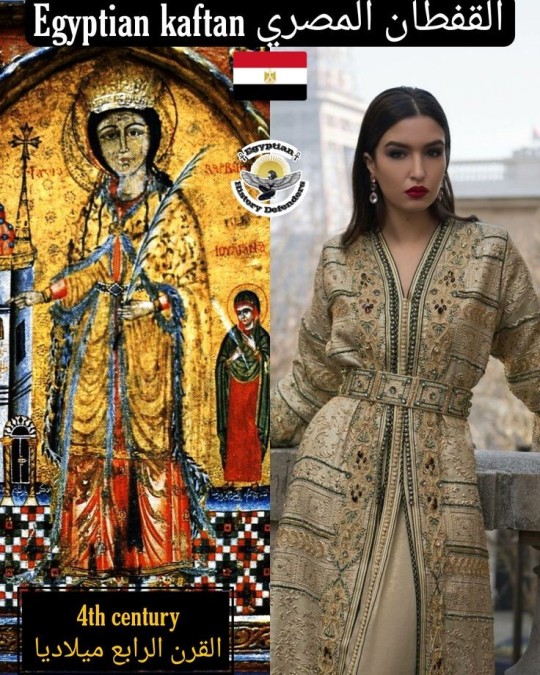

For the unfamilar "Egyptian history defender" is basically a dogwhistle as far as I'm concerned, whoever made this shit is 95% likely to be racist and freakishly preoccupied with hating Black Africans
Youre an Egypt defender and you chose photos of two women in what I'd identify as Moroccan dress? (I could just be unfamiliar but these designs look VERY Moroccan and I don't know of Egyptian designers making soutached caftans like these)
Youre a history defender and you don't know the second woman here isn't wearing a dress with a caftan on top? She's wearing a tunic with wide clavi (patterned stripes)- it's one garment and has no resemblance to the modern image used as comparison
#cipher talk#Also I don't think the left is 4th century. Lmao#The painting style is reminiscent of the 9th century at the very earliest and I instinctively think that's too early#The clothes certainly don't make sense for 4th century Egypt#That style of cloak wasn't common in paintings- the casula was (its sort of like a poncho)#A jacket like that wasn't. Worn? The closest thing was the Sassanid riding coat (which looks quite different)#A red long tunic is perfectly possible though#My guess is it was actually painted in the 17th-18th century because it looks like icons I know of from that era
2 notes
·
View notes
Text

The next Arthurian knight that refutes the misconception that every character in the Arthurian mythos had to be British or otherwise exclusively Western European.
Morien was a Knight of the Round Table whose life was narrated in the 13th century Arthurian poem “Moriaen,” written in the Middle Dutch. His father was the knight Aglovale, and his mother—a princess from a “Moorish” land. Just like the common imagery of Arthur’s court doesn’t have a strictly defined era or cultural affiliation (you’ll see hundreds of paintings of 6th century British knights wearing 17th century French armour), this image represents Morien as more of a legendary figure, combining regionally accurate elements in a bit of an anachronistic fashion. One of the first cultures to be referred to as Moors by the European Christians were the Maghrebine Berber people, giving some context to which region Morien's mother could be from. Amazigh-style weapons served as a basis for his weapons, while Tuareg dyeing techniques the design of his clothing. The description of his “Moorish” clothes and his armour as black as a raven reminds me of the beautiful indigo fabrics of the Tuareg people, which can appear to shine like raven feathers. His sword is barely visible, but it is based on the flyssa, an Amazigh traditional sword. He also holds an adarga, the Amazigh leather shield, which was actually so good at—well, being a shield—that it was adopted by many cultures of Europe because of its efficacy.
5K notes
·
View notes
Text
Fully obliterated because my phone gallery likes to categorize my photos all cute but mostly just shoves random photos into these groups cause I save all kinds of images to my phone sometimes and anyway looking at what it called "Pets!" With the header being my sister's golden retriever puppy only for the following picture to be a depiction of Jesus christ dead off the cross. Fully obliterated on impact.
#its an image of like a 17th century baroque painting i have saved as inspiration for art i never make anyway so idk why i bother#i'm not christi*n but i do have a relationship to it whether i like it or not so sometimes i wanna make weird art about it#i'm just terrible at following through on anything still but hm maybe one day
0 notes
Text
"A van Dyck," Dream drawled, dragging a light finger along the gilt frame of the painting propped on the top of one of Hob's shelves. Hob really should do something more formal with that. "Interesting thing to have in your living room, Hob."
"I tell people it's a print," Hob said, coming to stand beside him and handing him his tea.
"Oh, but it is not." There was a smirk dancing on Dream's lips, Hob knew without even looking at him directly.
"Makes sense that you'd be able to tell," he sighed.
"Of course. Just how did you come across such a thing?"
"Well, I was still mingling with the aristocracy in the early 17th century. Met some interesting people." He shrugged. "Really should have sold it when I was, well, destitute, but couldn't bear to. Managed to stash it away. One of the few things I have of that time, actually."
"I can only imagine you had more than one valuable thing in your possession over the centuries," Dream mused, sipping his tea. "Why this one?"
Oh, God. He knew, didn't he?
Hob rubbed at the back of his neck. "Reminded me of you."
Hob had never known much about art, particularly back then. He hardly would consider himself a collector and certainly not a connoisseur. But that particular portrait had caught his attention immediately for its similarity to Dream.
The likeness was, indeed, striking. His hair was longer than it had been when they'd met in 1589, sweeping over his shoulders, and his features were half-draped in shadow, but his eyes. Hob would know that haughty, intense gaze anywhere.
He'd never quite discounted the idea that it was a portrait of his stranger, except that he couldn't imagine him having the patience or cause to sit for it, or the desire to be immortalized in that way.
"It is me," said Dream.
"What? Seriously?" Hob turned to stare at him and found Dream already looking back, ethereal and lovely. There was only one lamp on in the living room, night falling around them, and it cast his face in a similar light to the portrait, soft gleaming skin and plunging darkness as backdrop, limitless shadow in his eyes. "You, allowing a portrait? You're not having me on?"
"I do not joke." Dream took a step closer to him, setting his tea aside on a table. "I suppose I must have been in good humor that day."
Hob raised both eyebrows. "Oh, uh-huh, you in good humor?"
Dream's lips ticked up in a half-smile. "It happens occasionally."
Hob leaned against the shelf, careful not to jostle the painting. "For someone who so disdains the waking world, you sure are very aware of the art scene."
Dream leaned beside him, tilting his head. "You might consider me a patron of the arts."
Hob chuckled. "A patron? Or an inspiration?" He reached out and dragged his thumb along Dream's lower lip. "Dream?"
"A lover of artists, perhaps."
"I'm sure." Hob swept a hand along his cheek, breaking up the light like he was dragging a wet brush through paint. "You look like you could have stepped right out of that painting right now. You could have stepped out of any painting."
Dream looked at him from under his lashes. "Are you calling me a work of art, Hob Gadling?"
"Always."
Then Hob kissed him, hands framing his beautiful face. Dream was like an artwork, constant in essence but changing interpretation in every new light. Hob could imagine how many people over the centuries had had a fleeting encounter with him and come away changed, just as he had.
Dream hovered near him when they parted. Hob looked over to the painting again. No mere depiction could capture Dream in all of his colors, but it really was a rather good try. Van Dyck had gotten the depth of his eyes just right.
"The Baroque period suits you," Hob told him.
"Now who knows something about art?"
"I've picked up a few things over the years. I'm in love with the world's greatest artist, after all."
Dream moved in as if to kiss him, but paused to speak against Hob's mouth. "There are other works of me out in the world, if you care to seek them out."
"Don't open that challenge because I will do it," Hob informed him, quite seriously.
"I hope so." There was a sharp gleam in Dream's eyes. Hob could only imagine what kinds of paintings might inspire that look. "I look forward to seeing what you find."
#this is so like. specific to MY interests XD#dreamling#dream of the endless#hob gadling#the sandman#dreamling fic#i think about Dream and art a lot#and also Hob having random weird expensive stuff just casually in his flat#kinda wanted to use a more dramatic baroque artist for dream than van dyck but i just really like the way he does EYES and GAZES#also he worked in england so hob could have conceivably come across his work? idk#i don't actually know anything about art i just guesstimate#my writing
2K notes
·
View notes
Text
My First Fanbind! A Black Sails Fic Anthology Series
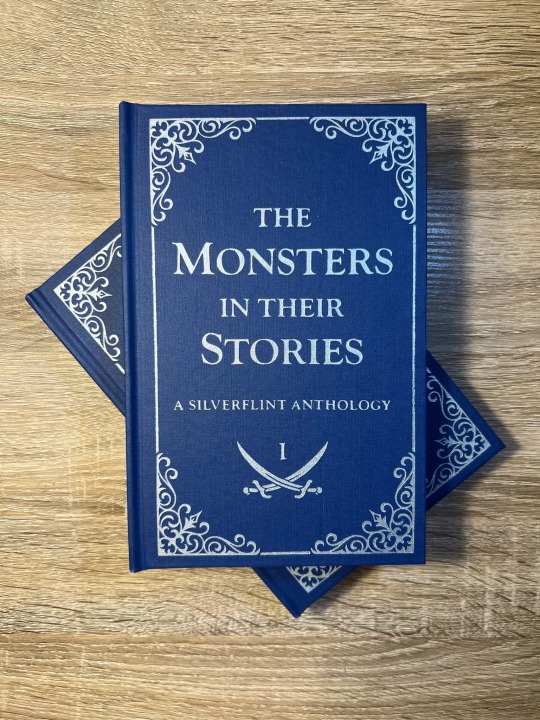
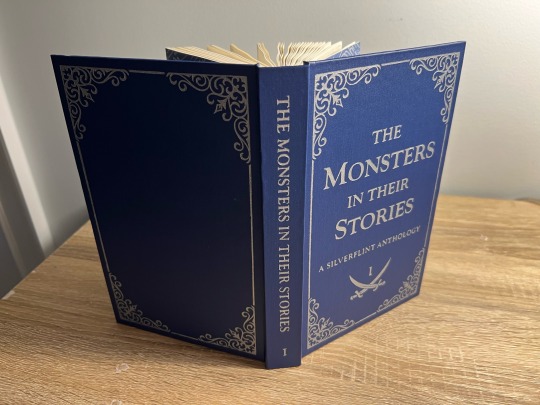

It took me a year (and a lot of anxious research) before I worked up the courage to bookbind fanfiction, and after months of on-again-off-again work, my first fanbind is finally done!
I knew that if I was going to bookbind fic, I had to bind something from the Black Sails fandom, aka the fandom and show that have had the biggest impact on my life. Y'all, I almost went into academia to study slavery in the 17th-18th century Caribbean because of this show - when folks say this show rewires your brain chemistry, they are NOT kidding. THEE show of all time. Happy 10th anniversary to Black Sails! This fandom is small but mighty. May we continue to get our hearts and souls blasted to smithereens by this show for many years to come.
Ao3 abounds with magnificent Black Sails oneshots, so I decided to put together an anthology of my favorite Silverflint fics under 20k, which I split into two volumes. Included are works by @justlikeeddie, @vowel-in-thug, @balloonstand, @annevbonny, @francisthegreat, @nysscientia, and more! Thank you, thank you all, you brilliant wonderful people, for gracing the Internet with such amazing writing. When I read the fics in these anthologies I want to fling myself into the sun.
More on the design and binding process below the cut!
Vol. 1 Page Count: 270 (12 fics)
Vol. 2 Page Count: 248 (11 fics)
Body Font: Sabon Next LT (10.5 pt)
Title Font: Goudy Old Style
Other Fonts: IM Fell English, pirates pw
The typeset (which I did in Word) took a while, mainly because I'd never done it before. Manually adjusting the hyphenation line-by-line was especially tedious. After making these books, I abandoned Word in favor of InDesign, in large part because InDesign gives you way finer control over your justification and hyphenation settings.
Regarding my actual design choices, I'm happy with how the ocean motif on the title page turned out (it's not the same pattern as my endpapers, but they're complimentary) and I'm very fond of my divider dingbats, which are little swords! Goudy Old Style was a fun title font to use, since it's the font that Black Sails uses as its logo. The stories in Vol. 1 are divided into parts based on what Silver WAS at that point in the show (cook, quartermaster, or king), and Vol. 2 is split up into comedies, histories (AUs set in the canon universe) and tragedies - befitting Black Sails' Shakespearean ~vibes~.

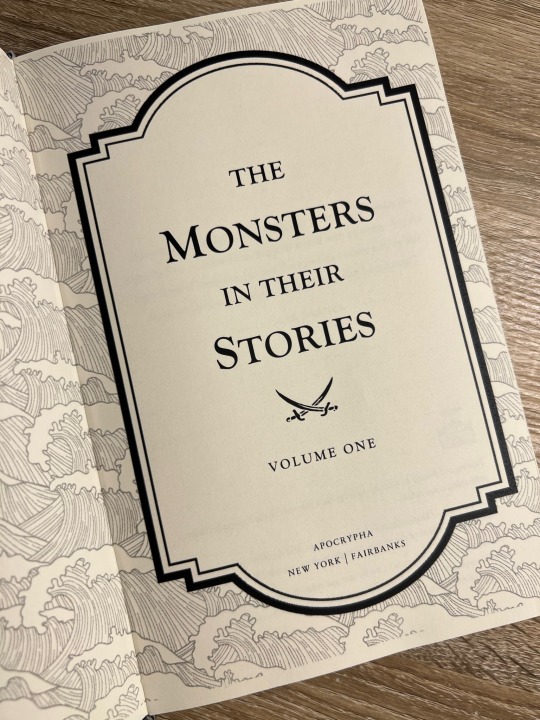
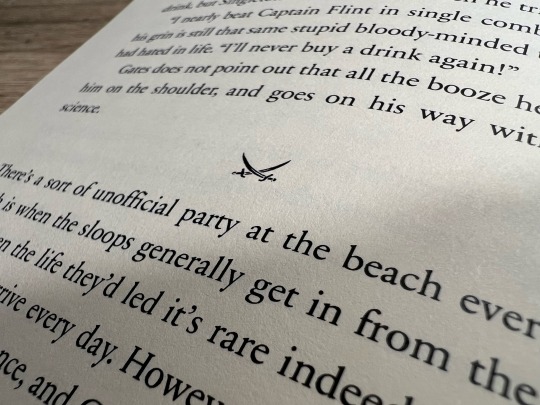
I stuck to a flatback binding, as I wasn't feeling quite ambitious enough to try rounding and/or backing. I've learned that I ~Anakin Skywalker voice~ hate sanding, enjoy folding/sewing, and don't LIKE edge trimming but enjoy the results enough to make it worth it.
The real adventure was decorating the cover, which remained bare for months. After agonizing over Illustrator and experimenting unsuccessfully with HTV and lokta paper embossing, I ultimately turned to using stencil vinyl to paint on the designs. There was a bit of seepage under some of the stencils, but I was able to scrape off the excess with my Cricut weeding tool without damaging the coated surface of the bookcloth (probably Arrestox Blue Ribbon from Hollander's). Even though it was very time-consuming, I'm so happy with the end result of the stenciled paint job and I intend to stick with stencils for my foreseeable future binds.
Are there things I would change? Sure. It was humid out when I printed, so the pages have got a wave. There’s an extra two pages in Vol 2. that I have no idea how I missed, and I got a line of glue in the middle of one of my Vol. 2 endpapers. I’m pretty sure I didn’t case in quite right, since my endpapers pull away from the case at the spine. I think the inner margins are a bit too big, and despite going line-by-line there’s still some wacky justification spacing in the typeset. But man, am I proud of these books! It is so satisfying to learn a new skill - MANY new skills, if we’re being honest - and to make something both beautiful and practical. If I’m still binding in two years or so, I can see myself redoing the typeset in InDesign, cutting out the existing text block, and reusing the cases. I’m also already planning for Vol. 3, which will be Silverflint Modern AUs.
Thanks for reading!
#bookbinding#fanbinding#ficbinding#my books#black sails#silverflint#fanfiction#bsanniversary#10yearsblacksails#10bsfest
270 notes
·
View notes
Text
If Caravaggio were alive today today, he would have loved the cinema; his paintings take a cinematic approach. We filmmakers became aware of his work in the late 1960s and early 1970s, and he certainly was an influence on us. The best part for us was that in many cases he painted religious subject-matter but the models were obviously people from the streets; he had prostitutes playing saints. There’s something in Caravaggio that shows a real street knowledge of the sinner; his sacred paintings are profane.
Martin Scorsese on Caravaggio
Michelangelo Merisi, known to most of us as “Caravaggio,” was born on September 29, 1571 in Milan, Italy, to parents who were from the small town of Caravaggio. In the span of his 38 years long life he revolutionised painting with innovations like a unique use of chiaroscuro - with dark shadows contrasting with dramatic areas of light - and a deep sense of realism that later inspired the Baroque movement. But most of all, he developed such an iconic style that most of us can probably look at a painting and know if it’s a Caravaggio, or Caravaggio-inspired.
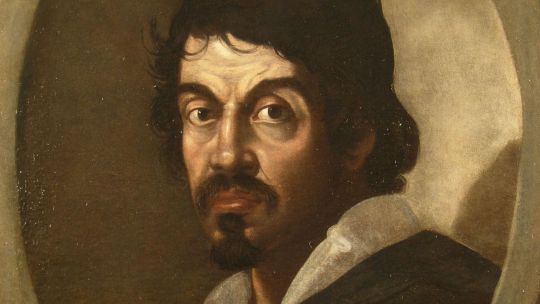
Merisi spent the first few years of his life in Milan, studying painting, and later moved to Rome, where his early talent impressed Cardinal Del Monte, who introduced the young painter to other high-profile Catholic figures who became commissioners of some of Caravaggio’s best work. It seemed there was no end to the artist’s creative genius. Caravaggio, much to his patron’s delight, would pump out one masterpiece after another. It seemed the more out of control his personal life became (cheating, brawling and murder were standard fare), the more his art would become more refined, more potent.
In the long list of masterpieces he left behind, both secular and religious works stand out. But it is perhaps in his religious works that the artistic transition of the master is more evident. Caravaggio is, in fact, known to have changed his style after harsh personal life experiences led him to reassess his outlook on life.
In May of 1606 Caravaggio took part in a deadly brawl in Rome and was charged with murder. He fled to Malta, in search of asylum from the Order of Saint John, a Catholic order dedicated to helping the sick and the poor. The order commissioned some of the most important late life works of the Milanese artist.
It is in these works that we notice the shift in Caravaggio’s art, from a strong focus on aesthetics to an interest in the spirituality of his subjects, which critics believe was motivated by his own introspection.
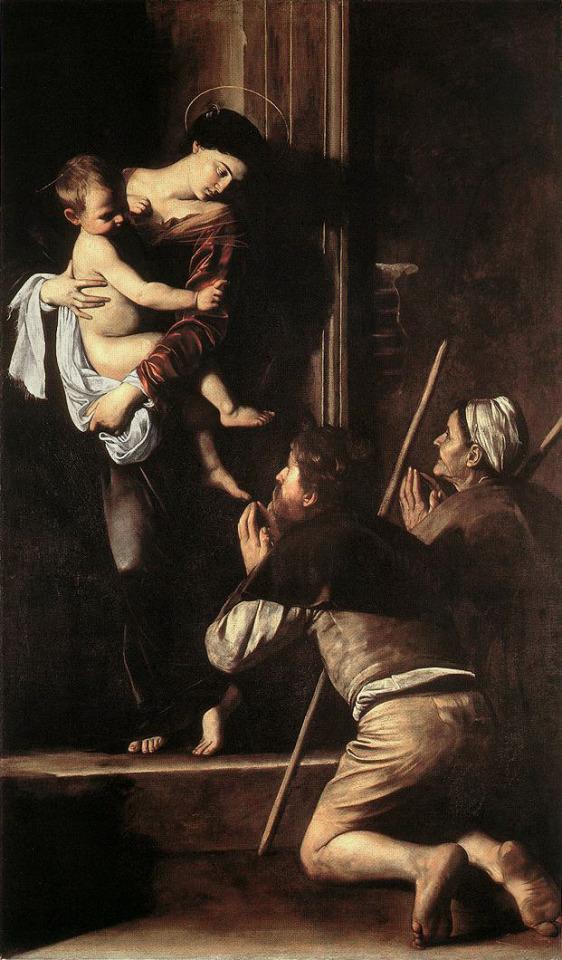
On the streets surrounding the churches and palaces, brawls and sword fights were regular occurrences. In the course of this desperate life Caravaggio created the most dramatic paintings of his age, using ordinary men and women - often prostitutes and the very poor - to model for his depictions of classic religious scenes.
By representing biblical characters in a naturalistic fashion, typically through signs of aging and poverty, Caravaggio's populist modernisation of religious parables were little short of trailblazing. Although not without his critics within the church, by effectively humanising the divine, Caravaggio made Christianity more relevant to the ordinary viewer.
For some, though, his art was too real. Bare shoulders, plunging necklines, severed heads; this raw humanity didn’t always fly in 17th century Rome. As a result, many of his pieces were rejected as altar pieces and as church hangings. One such piece, the Madonna of Loretto (now hanging in a church in Rome) was widely criticised upon its unveiling. The people of the day were shocked to behold the Mother of God leaning nonchalantly against a wall in her bare feet while holding baby Jesus in her arms.
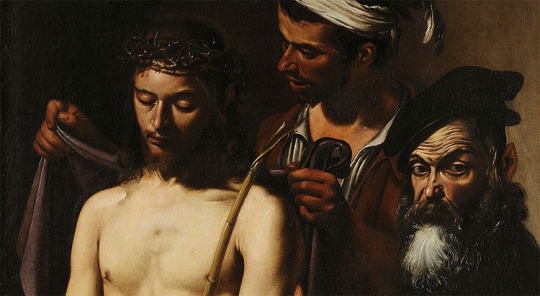
It is ironic that the very art that today we consider “classical” and “iconic” to the Catholic faith was considered questionable and perhaps void of modesty and virtue. Yet, the fact remains that no individual artist has made such a lasting impression on the world of modern art. Truly, many have called Caravaggio the “first modern artist”. It is no surprise, then, that his style has sparked both widespread admiration and imitation throughout the centuries.
Before Pope John Paul II refined a theology of the body beautiful, Caravaggio's paintings suggested a reverence for the inherent beauty of human form.
Troubled though he may have been, his art speaks eloquently of the dignity of the mundane. Though the original medium may be weathered and cracked, the message of beauty still echoes down the centuries. And this same beauty still fuels, escapes and reduces artists to relentless seekers as surely and as forcefully as it did in Caravaggio's life.
#scorsese#martin scorsese#quote#art#artist#caravaggio#art history#aesthetics#modern#sacred#profane#rome#catholic church#christian#beauty#realism#art of the mundane
400 notes
·
View notes
Text
𝐅𝐢𝐥𝐭𝐡𝐲 𝐑𝐢𝐜𝐡
Joseph Quinn x Fem! reader PT.1



✧ Synopsis;; Joseph Quinn was filthy rich, for he was royalty. Handsome, charming and a gentleman, a dream dressed in pure silk for any kind of woman. But not you.
✧ y/n is a mere slave of a nobel family who just turned 18. On the night of the prince’s royal ball she is dragged against her will to this dance just to be used as a coat rack for the purses and coats of the family ladies, who, of course, treat her like absolute sh’t, to the point where they could agreed to hand her over for a generous amount of gold.
“Just name your price, sweetheart.”
“Screw you, my prince.”
Just how lucky you were for had caught the
prince’ s attention!
< enemies to lovers 3
17th century royalty!

ATTENTION!! this is not Arthur Havisham, i only used the photo cause it resembles the appearance i want to give Joseph in this story. I would never use Arthur since he’s not attracted to females!!!
A/N;; i’m sorry if this is sloppy and like…, BAD, english is not my mother language and it’s my first joseph x reader story. either ways, i hope y’all like it. <3 comments and reblogs are appreciated!!!
CW;; this series might include 18+ content (details will be given at the start of each new part uploaded) MINORS DNI AND SKIP!!!
Please, under no circumstances, repost my work on any other sites. I do not consent to anyone taking my work and posting it as their own.
WARNINGS PART ONE: mention of blood, abuse, cursing and slave trafficking.
WORD COUNT;; 2k!
(A/N pt.2; it is much enjoyable(??) if you read it with a british accent since this fic takes placed in the U/K)
:¨·.·¨:
`·. lastly; enjoy! <3

Her faced seemed to tell everything: she hated it.
She hated everything. From the music, to the little stupid shoes that clacked against the floor. The floral scent, the wine, the giggles… She hated the ton*. Every single one of them,
Everything. It was a goddamn nightmare.
“y/n! You are letting my coat slip! Do i have to tell you how much it costs?! If you dare let it touch the floor I’ll take the money out of your poor allowance to pay for a new one!” one of the misses glared at you, hitting you in the face with her closed paper fan, its gemstones leaving marks on you cheek.
“We might as well do it anyways, since her filthy hands have touched them already!” her sister laughed, grabbing your face in between her gloved fingers and digging her nails in your skin. “Don’t you think so, y/n? What? Cat got you tongue?” they giggled.
“Children, children!” the woman of the house hushed them with a sweet smile. “You shall never touch her!” she said, taking of the gloves out of her daughters hands to give her a new pair, with a sweet smile telling one of the servants of the castle to burn them. “God knows what she might infect us with!” she laughed, her offsprings following her.
God, you hated her. Her and her stupid daughters. With their stupid dresses and stupid painted faces.
You glared at them, your grip tightening around their belongings, holding your stare and your head up even when the woman stared back at you, her face scrunching in disgust and anger.
“Who do you think you are staring at?!?!” she suddenly yelled, catching the attention of those who enjoyed drinks and company around her, not waiting a mere second to rise her hand and slap you to ‘show you your place’. You took the hits, the metallic flavor of blood filling your mouth due to the continues smacks and hits with the back of her fan. “You filthy ungrateful bitch, you dare stare at us? Who give you food and a bed?! I should’ve let you died out in the cold, in the dirt, where you belong to!” you gritted your teeth, your eyes down to the floor as your free hand made its way to your bottom lip, where you felt the skin split, the crimson of fresh blood tinting your frail skin.
“Fucking fussock*.” you cursed her under your breath, loud enough for her to perfectly hear you.
“What did you say?!” her free hand gripped your long and matted locks, making you look staring into her enraged eyes, her other hand rising up to hit you once again.
Your eyes closed as you expected a new slap, which surprisingly enough never came. The sound of multiple gasps filled your ears and when you opened up your eyes once again, your stomach sank at the sight of…
“Your highness!” everyone suddenly diverted their eyes to the floor, including you, your mistress and her daughters bowed in his presence, the wrist of the first of them all gracefully and softly held by the prince’s, who let her go with a kind smile.
“Is everything alright?” his voice tested the waters, his tone low and soft as the silk he dressed in, his hands jeweled in silver rings joining and intertwining in an elegance you never had witnessed.
“Yes, your highness.” the woman stuttered, showing a nervous smile. “Our slave just seemed to…, misbehave, your highness.” your eyes travelled trough his tall and magnificent demeanor. His crimson blood suit matched perfectly with the snow of his skin and his brown and perfectly combed curls.
Your eyes quickly darted always as he had caught you staring once he had turned to you. He fought the lopsided smirk that urged to grow in his lips, stepping closer to where you stood.
He took a glance at the ragged clothes that hid your bruised and malnourished body, probably due to the family’s treatment under your care, your matted hair, cut up hands…
His warm touch spread on your skin as he took your chin in between his thumb and index finger, softly trying to rise your head up, but you denied him, in a harsh turn of head freeing yourself from his touch before giving him a glare.
A new wave of gasps filed the air as you stared right into his eyes, him holding your glare.
You didn’t care if he was a noble or pure royalty. Those ‘pure blood’ were all the goddamn same. With their leather shoes and gold jewelry, fancy words and silk dresses and suits. Their appearance was only a pretty facade that hid the ugliness of their insides.
You hated all of them. Might as well just get your head off as soon as possible.
“You slave! How is it ye dare to stare at the prince, soon king?!” a blonde and tall man talked, you recognized him as the pince’s right hand, but only with a wave of this hand, he stood silent beside the prince.
“Huh…” the smile he had been trying to fight off finally took place on his gracefully sculpted face and full rosy lips. “Interesting.” once again he took a soft grasp to your face, this time not letting you go even if you fought him off. His eyes took everything your face offered him, from your perfect nose to you long eyelashes and your beautiful fierce eyes, which stared at him with pure hatred and anger. “How much?” he suddenly asked, still not drifting his eyes away from you.
The woman stood frozen in place, just like her daughters.
“What does your highness mean with…-”
“How much would you want for her?” he cut her off, the deadly silent that fell on the salon almost giving you chills.
What was he saying?
“Your highness, I can’t…” she was short of breath and words. “I surely doubt thee would want her under your care, she…”
“I don’t care about any of it. Name a price.” everyone was shocked by the situation. Buying and selling slaves was something quite common, that’s how your current ‘family’ have got you, but this…
The prince? Has he gone nuts?
“Your highness, I don’t think…” the prince’s counselor stepped in, shutting up once again as soon as he gave him a glance.
“50 gold coins.” the woman suddenly blurted out, everyone’s jaws dropping at the audacity of the woman and such large figure.
“Mother!” her offsprings whispered-yelled. Not believing her words.
50 gold coins?!
You scoffed, smirking at such nonsense, not noticing the staring of the prince due to your reaction.
She wished you were worth that much. He would never…
“Make it 150.” he closed the deal.
“Your highness!” the counselor exclaimed, completely alarmed.
“I don’t wanna hear it, Ballard.” he hushed the blonde.
You watched as the woman who once abused you and starved you for days fainted due to the prince’s words and his daughters kneeling down to help her followed by some of the nearby guests, fanning her pale sleeping face.
You too felt like fainting.
“Hey, eyes on me, sweetheart.” the prince caught your attention once again, when your eyes met a smile growing on his lips. “All you need to do from now on keep your eyes on me.”

“Get off of me!” you screamed at the servants that tried and strip you out of your clothes, pushing their hands away. “I said stop!”
“Miss, they’re orders from your highness.” one of them spoke, his blue eyes soft on you. “He wanted us to help you bathe and and get rid of your dirty clothes.” she explained.
“I don’t care about what he said.” you scoffed. “If he wanted me undressed so fast why isn’t he the one taking my clothes off?” they all gasped at your words and no respect to the prince.
You didn’t care though, they were all the same anyways. Always reaks* that just wanted to have women swoon at their feet. Maybe that’s why he had bought you, just to use you when his cock got cold.
Suddenly, the door on your back opened, the heads of the servants quickly lowering as your eyes met the prince’s.
“Oh, fantastic…” you muttered. Just what you needed at the moment.
“You heard her, ladies. You are all dismissed.” he smiled at every and each one of them, bowing and moving aside with a swing of his arm on the door to let them out, all of them bowing and giggling.
And weren’t you just right?
“Great. And what do I have the honor of your highness’ presence for?” you sarcastically inquired him once he had closed the door behind his back, noticing…, ‘Ballard’ outside. “Got too excited due your new acquisition to just wait?” you mocked him.
“I heard you were putting up a fight.” he smiled, ignoring your words whilst looking at you up and down. “Is there something not to your liking, perhaps?”
“‘Not to my liking’?” you scoffed. “I can’t believe thee.” you shook your head, grasping at your locks as you stared at him in disbelief. “How about this whole goddamn situation? I mean, look at this!” you pointed out everything that surrounded you, the whole bathroom with a gigantic bathtub of quartz, marble floors and pillars… “A few hours ago I was being used as a coat hanger in your ball and now I’m in a bathroom with the prince, who, surprisingly enough, bought me for 150 golden coins god knows why?!” you exclaimed.
He stared at you with a funny look in his eyes. His back against the door as his eyebrows raised at you.
“What.” you spit out, a glare in your eyes.
“Nothing, is just that…” he stepped closer to you, his arms crossed over his chest. “You don’t seem to…, respect me.” he frowned, his voice low. “Not like all of them.”
“Oh, I’m sorry, your highness, for not being another dog licking your leather boots.” you bowed, more of his steps growing closer to you until his thumb took your chin, rising your head up so you could meet his eyes, his face stood serious for a couple of seconds, before a downside smirk grew on his factions. “Why haven’t you cut my head off yet?” you inquired him, not really understanding his behavior. By the way you treated him, any other prince would have already gotten you to the guillotine.
“Why shall I?” he answered with another question, his thumb caressing the wound on your bottom lip, the still fresh blood that stood on it staining his thumb as you hissed in pain, getting away.
You stared at him in confusion.
Yeah. He was absolutely nuts.
“The water will go cold if you don’t get in soon.” he said, drifting off the matter while whipping off your blood from his thumb with his handkerchief. “Are you sure you don’t want to get off those ragged clothes?”
“This is the only dress I’ve had, sir.” you said, his eyes meeting yours.
“What’s your favorite color?” you frowned at his sudden question, which made absolutely no sense. He made no sense. “Crimson, like the purest blood? The forest’s green? The ocean’s blue, perhaps?”
“I’ve never seen the forest nor the ocean, sir. I’ve never left the capital. Though I find the sky’s blue on spring pretty wonderful, not sure it does justice to the ocean’s.”
“It doesn’t.” he said, sitting in the edge of the bathtub, his fingers taunting the warm water. “The ocean is cold, and fierce…, untamable. But it can also be warm, and calm, and soft.” he tried to explain, and from your point of view it didn’t make sense.
It didn’t make sense but you found it…
“It must be beautiful.” you said, him flashing you a soft smile before nodding.
“It is.” he got up clapping his hands together before looking back at you. “Well then, you should really hurry up, the water is perfect.”
“I already told thee, this dress is the only-“
“You won’t need it anymore.” he cut you off.
“And why is that?” you inquired, his steps growing closer to you.
“Because from now on…” he said, catching one of your locks in between his fingers. “You belong in this castle.”
To be continued…

*fussock; a lazy fat woman…, a frowzy old woman.
*the ton; the ton actually refers to English high society during the Regency era, and encompasses every aristocrat from the royals to the gentry.
*rake; ‘rake’ is used to describe an immoral, hedonistic young man circulating in high society.
#joseph quinn#eddie munson x reader#stranger things#19th century#royalty#female reader#stranger things smut#eddie munson smut#joseph quinn x reader#stranger things fix it fic#joseph quinn fluff#eddie munson fluff#eddie munson x you#stranger things 4#stranger things x reader#peter ballard#eddie munson imagine#eddie munson fic#joseph quinn fic
1K notes
·
View notes
Text
one of the surreal things about traveling is the natural environment actually looking like artistic depictions of it
when looking at art of trees, its easy to sort of have your brain wash over them as "artistic depcitions" of trees. But then you go there, and no-- the trees there actually look like that.
this was my experience going to europe after seeing so many landscapes with european trees and foliage in them. Like the trees in europe really do look like the trees in that 17th century baroque landscape painting.
It was also my experience in virginia. You watch disney's pocahontas (1995) and those background paintings of tall trees with all the foliage on top wash over you as artistic license, and then you go to virginia, and it's like. oh, pocahontas (1995) did have exactly one (1) realistic thing in it. and it was the shape of the trees
46 notes
·
View notes
Text
I was looking for boot ref pics and then came across this painting

Oh my fucking god???????????????? Putting this one in the ref folder bcs oh my god??????????? They did not have to serve this hard?????????
#some random ass scottish lord and his bro from the english civil war era#and yet it is the single most slay painting ive ever seen in my entire life#paintings like this ensure me that i can really just draw any pose for historical stuff and it will never be too over the top#17th century twinks my fucking god#also its so important to me the difference in poses 😭😭😭😭#WHY IS THE GUY ON THE RIGHT SERVING SO HARD??? WHY DID HE FEEL THE NEED????#but yknow what! good for him#honestly he is how i imagine emperor seb(with longer hair tho)#the hair is literally perfect#the pose? mwah!!#oh my god and i just found a painting of their third brother and is serving just as hard#they died in battle pretty young </3 at least they got to slay first#also the painter made a bunch of self portraits and theyre just as twinky! good on you sir!!#his art is really amazing tbh :D new thing to reference yayyyyyyy#unfortunately the era is a bit before my AU but hey still good to look at#catie.rambling.txt
21 notes
·
View notes
Text
I went to a local art museum yesterday and I was shivering to my core. AI has made it into a museum.

The right panel is the third panel of a 17th century triptych (oil on wood). The left is an AI generated image with white painted letters over it.
I’ll try to keep it short as to why I don’t like this piece of “Art”.
A 17th century piece (which looks very pretty and well painted) completely taken out of its value, place, context ... Placed between “modern art”.
The panel was part of a triptych. Remake it at least as such or don’t add any additional work, as it was never ever intended to be displayed as such. (You can have them mirrored, but leave space between them).
Call me dumb, but my first instinct when I saw it was “both are fake”. The AI image looks good. But I really had to get close to find the paint cracks on the right panel to assure myself.
17th century art is as photorealistic as painted art got. The portrayal of emotions, movement, action, thought and light have never been more accurately put to life. On the left a dude just added a bunch of words into a computer….
Mind you, this picture was taken April 4th. The work dates “2024”. Some dude just really did this and the museum was like “gimme!” There hasn’t even gone time over it for the world to do something with it. No (online) debate, no gallery display, no articles,… it was just… made and hung up.
The artist didn’t even come up with an original idea (a Frenchmen in the 1970s did something similar). He didn’t even have the skill to manually create the mirror image. He just went to his computer, got himself white paint and had good enough handwriting to at least write in a straight line. “Art”
I’m not enough of a pro to go more in depth. Also art is never singular. Please, let’s start the debate. I’m curious to hear everyone’s vision on this.
22 notes
·
View notes
Text
Muslim pupils who expressed outrage after their teacher presented a Renaissance painting of nude women in class will be disciplined, France’s education minister has said.
A French teacher at the multicultural Jacques-Cartier college showed students the painting Diana and Actaeon by the Italian artist Giuseppe Cesari, which portrays a Greek mythology story in which the hunter Actaeon sees the goddess Diana and her nymphs bathing.
The work, which depicts a naked Diana and four female companions, is held at the Louvre museum in Paris.
Sophie Vénétitay, secretary general of the Snes-FSU secondary school teachers’ union, said: “During a French class, a colleague showed a 17th-century painting that showed naked women.”
“Some students averted their gaze, felt offended, said they were shocked,” said Ms Vénétitay, adding that “some also alleged the teacher made racist comments” during a class discussion.
A pupil’s parent sent an email to the school director saying that his son was prevented from speaking during that discussion and that he would file a complaint.
“We know well that methods like that can lead to a tragedy,” Ms Vénétitay told BFMTV news. “We saw it in the murder of Samuel Paty. Our colleagues feel threatened and in danger.”
Teachers at the Issou school said that pupils admitted lying about events in their art class but that the damage had been done.
“We’re dealing with vindictive parents who prefer to believe their children than us,” they said.
Gabriel Attal, the education minister, visited the school in person on Monday and later said that a disciplinary procedure would be launched “against the students who are responsible for this situation and who have also admitted the facts”.
A team would also be deployed to the school to ensure it adhered to the “values of the republic”, he said.
Staff at the Jacques-Cartier middle school in Issou, west of Paris, refused to work on Monday, saying they feared for their safety given the recent murders of two teachers by jihadi terrorists.
Dominique Bernard was stabbed to death by a Muslim man in his school’s playground in the northern town of Arras in October.
In 2020 a civics teacher, Samuel Paty was stabbed and beheaded by a terrorist in Conflans-Sainte-Honorine, 12 miles from Issou, after he showed his pupils a caricature of Mohammed in a class on free speech.
In an email sent to parents on Friday, teachers said they were exercising their right to stay away from classrooms over the “particularly difficult situation” and “an increase in cases of violence” as their daily reality.
Deteriorating discipline at the school
The school’s head teacher recently asked the education ministry for more staff and resources to deal with deteriorating discipline at the school, saying that fights and death threats and threats of rape had become common among pupils.
“We feel we are clearly in danger. We are supported by our direct superiors but not from higher up. This is a real call for help,” said one teacher.
Last week a Paris court convicted six teenagers over their role in events that led to the beheading of Mr Paty, who was their teacher at the middle school in Conflans when he was killed by Abdoullakh Anzorov, an 18-year-old of Chechen origin.
In another sign of school-religion tensions, the state this week said it would withdraw funding for the country’s biggest state-subsidised Muslim high school. In its teaching of Muslim ethics, the Averroes school, in Lille, was found to be violating French republican values.
On Tuesday, Jordan Bardella, leader of the hard-Right National Rally party, warned that “freedom of expression is under threat in France from an all-conquering political Islam that is imposing on our society its laws, its way of life and its prohibitions”.
39 notes
·
View notes
Text
Random saints by Sittow or Catherine of Aragon's parents?

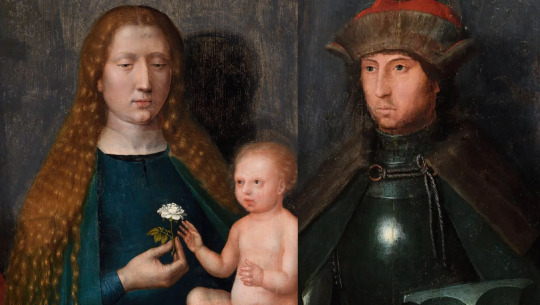
Read further if you wish to know what my theory is.
I first found this photo with mention it is by Sittow and at first I thought it is another portrait of Catherine. But quickly I realised this woman looks older and the features are not exactly the same.
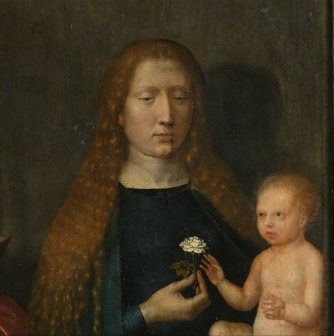
The nose is much narrower. And I started to wonder...we know that Sittow painted at least one portrait of Queen Isabella I of Castile.
And she had such nose. I could exclude possibility some of Catherine's sisters looked like this too, but women in that family tended to be very young-looking for really long.
So the age of sitter already is suggesting that it could be based upon Isabella towards end of her life. And it is also odd for depiction of Virgin Mary to depict woman who is not young...it is point in Isabella's favour.
While many claim Sittow painted Isabella in 1485, he was only born in 1468/1469 and didn't even become indipended master until at least 1488. He is first recorded working in Toledo in 1492. So he'd always be only able to depict Isabella over age of 40. And tbh, if this is her..then she looks great for somebody over 40!
But where is this image? It took me while to track down.
It's detail from wings of theThe Passion Altarpiece (Tallinn), its middle part is from c.1515-1520(with some 17th century additions) by different artist.

But I am not so sure how accurate is the dating of the outer wings by Sittow(1518-1525) which are in very different style, and might have originally belong to different altar middle.

If it is indeed 1518-1525 dating, then imo they are posthumous depictions based upon earlier sketches done from life. Sittow reusing those old sketches, using them as inspiration for his later work.
Link to photos only. Left pannel: https://artsandculture.google.com/asset/the-passion-altarpiece-outer-wing-with-the-virgin-mary-and-apostle-james-the-greater-paintings-of-the-outer-side-of-the-wings-by-michel-sittow-and-his-workshop/BwFnRG1v6gRqmQ
Right pannel: https://arthive.com/artists/75951~Michel_Sittow/works/526786~Saint_Adrian_and_Saint_Anthony
As to where they are located?
-Niguliste Museum(housed in former St. Nicholas' Church), which is part of Art Museum of Estonia(which combines collections from 3 other buildings+ this church). Hence in Tallin, Estonia but be aware there is over 3 km distance in between the church and other buildings.
But if anybody could go there and get us some pictures it'd be great (if it is allowed). Currently Niguliste Museum has exhibition about Sittow:

But back to the pannels. The left one depicts Madonna(Virgin Mary holding baby Jesus) and St. James the Great(apostle and patron saint of Spain:
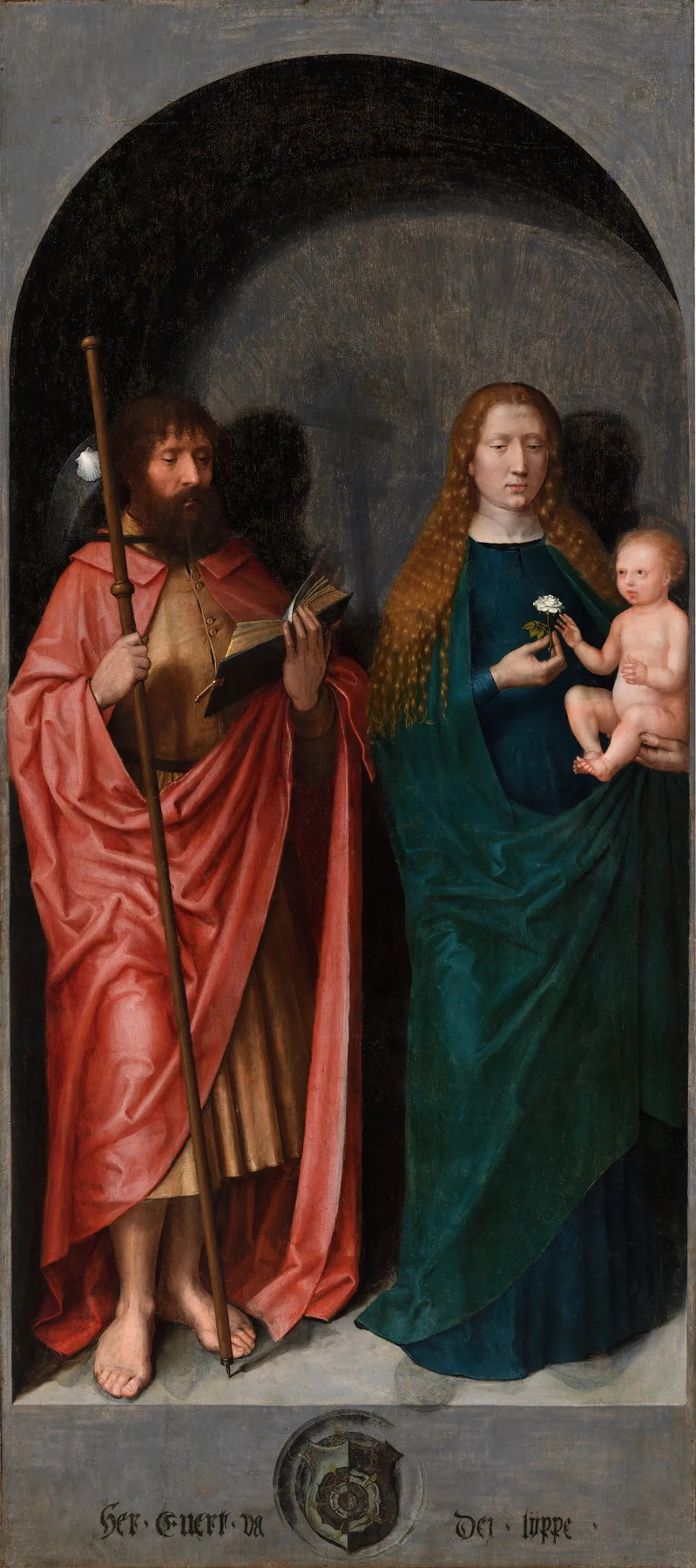
And please note that Tudor rose is combination of red and white rose and not always it was depicted as inner rose white, outer red. Sometimes they were halfed, with inner rose sometiems also switched.

Of course it could be some foreign coat of arms or later alteration.
Right pannel:

Here the coat of arms looks much newer and is probably altered(and if pomegranate turned out to be beneath it, I'd just die...)
The right pannel is depicting two male saints. On right is St Anthony the Great...was father of monasticism(of monastic life)...thus very important saint in christianity...
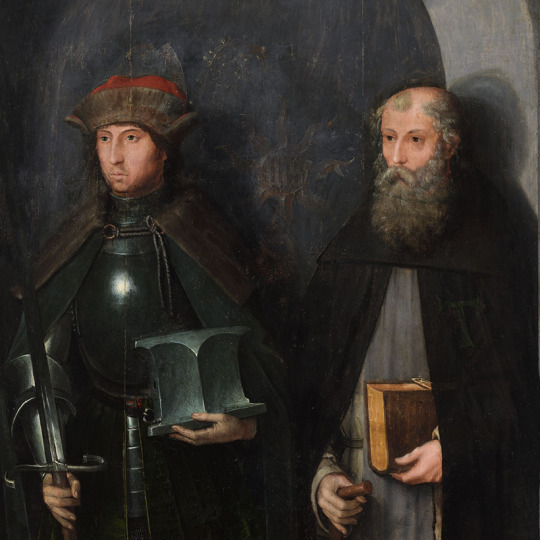
and on left St. Adrian of Nicomedia(2nd most popular military saint after St. George), and imo that's probably King Ferdinand II of Aragon:

It's not great likeness(brows not arched enough, looks bit slimmer, alla of nose not as defined), but overall it's enough of resemblence to not be able to exclude the possibility.
But if this is indeed done years after Sittow was in Spain...and he is reusing his old sketches of catholic monarchs to create this new religious scene(perhaps initially intended for them too, but never made into finished work before), then it is also possible that sketch done in pencil has partially rubbed off...and thus the differences in face of this male.
I think that if this was done while in Spain, such big differences are not very likely to occur. Not that pencil could not rub off, but I think Sittow would have noticed and cared about getting absolutely righ(to please his patrons) and thus would have corrected it.
Ehm, this kitty is supposed to be a lion:
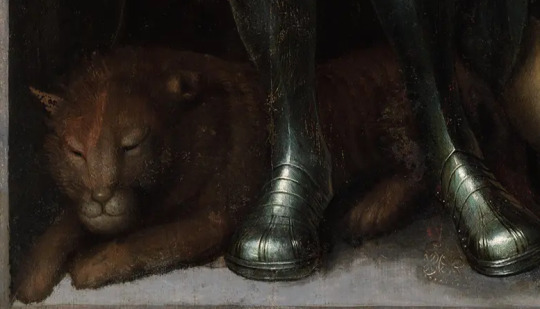
But you must be wondering, if Isabella indeed had this most vivid golden hair colour I always go on and on about, why does she have red hair here?
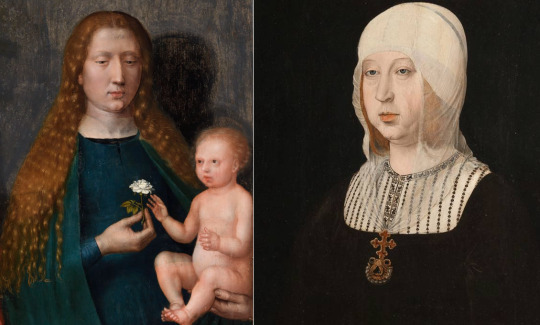
Several options to pick from: Pigments going wrong, Isabella's hair possibly turning to more reddish hues towards end of her life, or simply discoloured pinkish varnish which was very oddly applied...and on baby's skin you can see where somebody applied only one layer and where they went with brush for 2nd time.
If entire pannel has this varnish on, then it'd affect the hair, turning it more red. Why would such varnish not be removed? Sometimes money is tight and museums have multiple paintings to care for and those paintings in fairly good condition have to wait longer.
And sometimes it is not possible to remove discoloured varnish without harming the painting beneath.
Also worth of nothing is that Virgin Mary's dress is typically not teal, but vividly blue, the very best most expensive most vivid blue pigments were very often reserved for depicting the Virgin Mary:

Sometimes due to budget cost cheaper substitues were used, and those tend to fade.
Hence imo the colours originally might have been intended to be more like this(yes, I photoshopped it):

(I didn't change damn thing about male figure, just brightened it. But tbh I played with the woman's dress, skin and hair for while.)
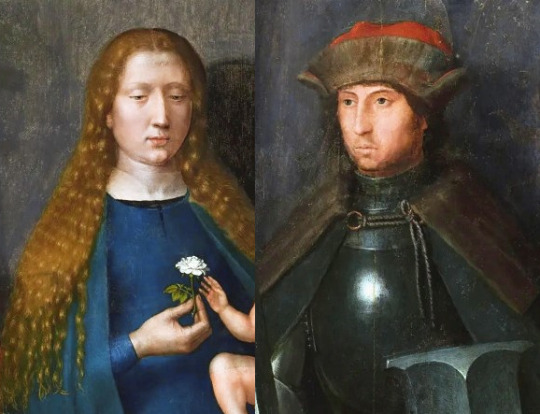
I mean if it looked like this now, fans of catholic monarchs would probably be all over it already.
But people overlook these dark slightly pinkish images located all the way in Estonia, even though it is atributed to Sittow himself!
(I don't mean people in Estonia, I mean people who search for Isabella's lost portrait by Sittow and stubbornly stuck to their favourite which is not even by Sittow!)

I honestly thought that people searching for lost portrait of Isabella by Sittow would have by now checked all his work, to see if perhaps she is there somewhere! Just doesn't look teen or young adult.
So I want you to be aware, if you're on quest of finding Isabella by Sittow's in that portrait with emerald necklace that this is imo the face you're looking for :

Possibly with hair bit more golden and skin more fair:
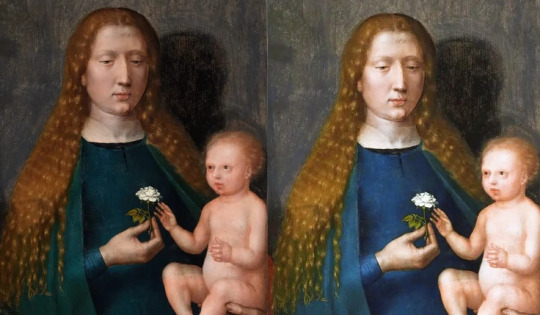
And it doesn't matter she doesn't look 20! She is still very beautiful.
Hence imo, these are Catherine of Aragon's parents, depicted in disguise of saints:

But I think they were likely painted years after Sittow left Spain, and his old sketches of them have been reused to create these pannels. I hope the experts will one day look more into this possibility.
I hope you've enjoyed this, and tell me what you think. Am I onto something or am I chasing shadows?


#historical portraits#isabella of castile#ferdinand of aragon#Isabella I of Castile#Ferdinand II of Aragon#sittow
69 notes
·
View notes
Photo

A new sword for the collection that is a significant diversion from my core collecting theme.
Circa the mid-17th Century, this style of sword is unique to the British Isles and was popular from around the time of the English Civil wars (1642 - 1651) up until the 1670s.
The prominent features of the style are a three-bar basket connected to a round pommel by screws. Joining the bars, are usually one or two pairs of crossbars across the front. The top of the hilt is normally a bowl shape with a flat tail at the back. The blades can be either double edged broadswords (like this one) or single edged backswords. In period this likely how they would have been described in armouries or wills.
Also distinctive is the level of decoration that features on the guard, with faces being the most common but not exclusive theme. The meaning behind the faces is lost, but some theories are that it was the Martyred King Charles I. And while this may be true for specific swords, the faces appear on swords with provenance to both sides of the conflict so is unlikely to be true.

To modern collectors and books, these are called Mortuary swords, a name that came into being in the Victorian era. Again, it is not known why, it could be the likeness of the King or that many swords were sold out of Church collections where they had been used for funeral rites. In 1700s it was the practice to donate a soldier’s sword to his church, who would paint them black and put them on display at funerals.
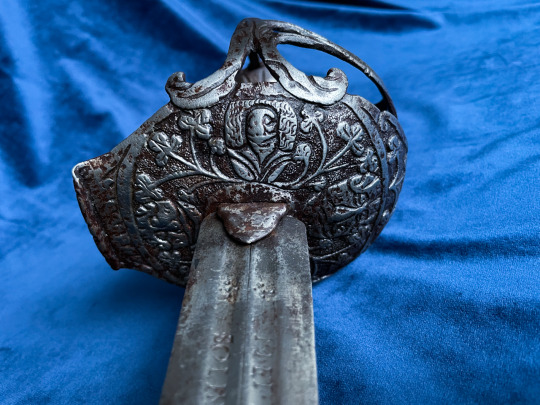
In the 19th Century, many churches were renovating and sold off these swords to interested collectors. Because of the practice of painting the metal, many remained in very good condition.
Typically associated with the cavalry, they were used by infantry as well, although a decorated sword such as this would have belonged to a man of some means. This sword is likely to be an infantry mans’ sword due to its’ lighter weight and shorter length, even if we account for it having lost the point of the blade. Another common modification to swords of this age was the replacement of the grip and wire. Wood does not age as well as steel and it is safe to assume that most 17th Century swords have had the grip re-done. Early collectors and museums looked on artifacts as works of art more than pieces of history, so like a painting restoration, they sought to re-make swords in their image of what they thought it should be.
I believe that this sword possibly came from one such church, as the blade is still stained and there are traces of black finish on the guard. Most of the blades for these swords came from three sources, the English Hanslow smiths, The Low Countries and of course Solingen. However, one cannot go by the markings alone, as forgery was wide spread.
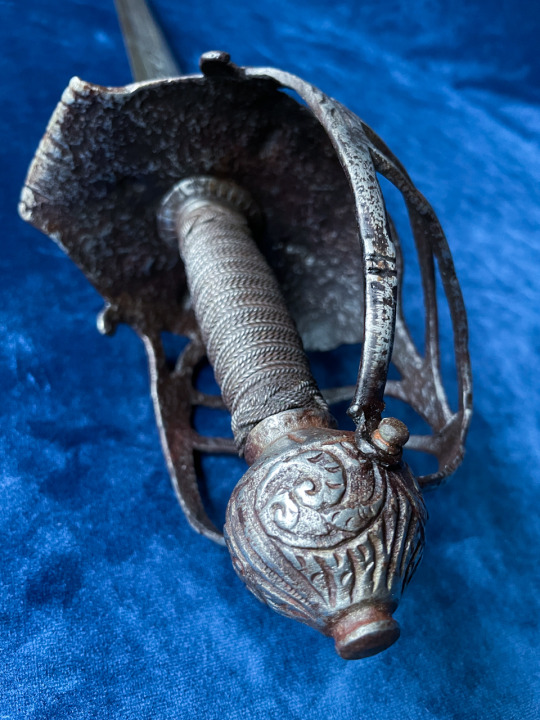
The blade on this sword has several interesting features. It is marked on both sides with the words:
MEFECIT A running Wolf and Tree stamp SAHAGVM
SOLINGEN SAHAGVM
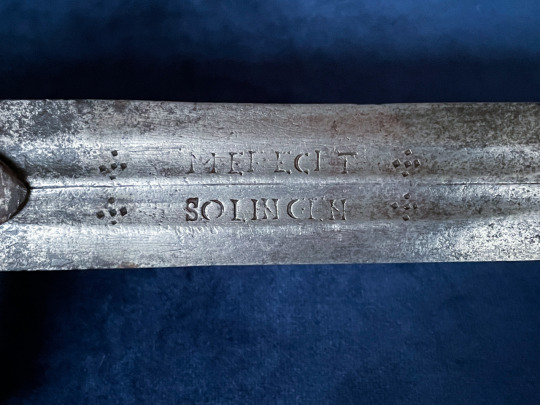


Sahagvm is a reference to Alsonso de Sahagun, el viejo a legendary Spanish
sword smith of the 16th Century. The name features prominently on Dutch ‘Walloon’ swords of the time and is an obvious forgery in line with the ‘Andrea Ferara’ swords of the Scottish Highlanders. Furthermore, the orientation of the wolf in relation to the text is incorrect likely ruling out manufacture in Solingen proper. However, this was a time of trouble, and many families of smiths left their German base to settle in the Low Countries, Britain or further abroad.
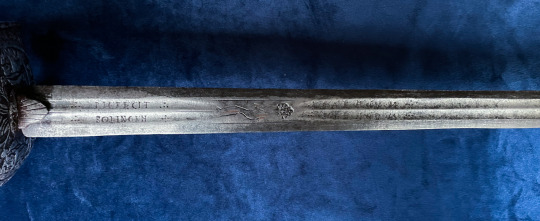
A light sword, the blade specifications are still functional and a close match to those of my 1796 Pattern Heavy Cavalry dismounted service sword with the Andrea Ferara blade.
Overall Length: 992 mm
Blade Length: 830 mm
Grip Length: 146 mm
Inside Grip Length: 100 mm
Weight: 860 grams
Point of Balance: 85 mm
#swords#17th Century#English Civil War#Cavalry#Infantry#Broadsword#Basket-hilt#antiques#military#collection#collecting history
337 notes
·
View notes
Note
love your addition to that post about misinformation earlier this month, genuinely, but your summary of the situation re: the medicinal ingestion of human corpse matter in europe is kind of misleading. among other things, i don't know anyone who would call the 17th century "medieval." paracelsus didn't even die until the 1540s. periodization is complicated and mostly bullshit when people look for hard lines between "eras" of human history, but using terms that conjure an idea of a time literal centuries removed from the things we're talking about obfuscates the proximity and connections between things like corpse medicine, anatomical theaters, criminalization/execution, and the development of the modern western medical system. sorry for the long rant in your ask box, i just have a master's degree in Literally This.
to be clear, i am not at all arguing that the mummy being used medicinally was always or even often made of Egyptian mummies. i just wanted to be annoying about time periods. though by the early 1600s physicians like oswald croll were outwardly recommending fresh (executed) european bodies as the source of mummy, so i do kind of take issue with the assertion that people always thought they were buying something different. anyway, as a parting gift thanking you for making it this far in my longwinded asks, did you know moss grown on a human skull was also a source of medicine? called muscus ex cranio humano or usnea humana.)
Ohh huh. Thank you for messaging me; this is a lot more context than I had when I made my post.
I’m an American archaeologist (that is, I work in the Americas), so my areas of specialty are the US Southwest/Mexican Northwest ca. 800-1400 CE, and New England (or okay mostly Massachusetts and some New Hampshire) 1700s-1800s. I also have a solid grounding in the Bronze Age Aegean. But what that means is that early modern Europe is not my forte at all, and I did what I caution about doing and relied primarily on Wikipedia and a tumblr user I find reliable for that information. There were some quick to find sources that supported an 11th-12th century origin for the eating of ancient Egyptian mummies as medicine, which is what I meant by Medieval. I also kind of thoughtlessly took “mummy” to mean “ancient Egyptian mummified human remains” when of course ancient Egypt did not hold a monopoly on corpses or even mummies. I wasn’t intending to speak about the ingestion of human corpse matter as a whole, just Egyptian mummies. But both of these made the result end up misleading and not fully true, and I’m sorry about that.
There’s a specific cultural image of Victorian Britons opening sarcophagi and eating mummies that they looted from thousand-year-old Egyptian tombs, and it becomes a thrilling/disgusting synecdoche for British imperialism in Africa. That’s the part that’s a myth (though 19th century Egyptomania was real and the mummy unwrappings and some mummy-paint were also real.)
However, I was not well informed about the scope of European corpse medicine throughout history, and was honestly shocked to learn just how widespread and recent it was! And for sure you’re right, the 1500s-1600s when European corpse medicine was at its peak is hardly medieval. They mostly weren’t eating ancient Egyptians by that point (though they seem to have been at least a little, because in the late 1500s bodies were still being smuggled as contraband out of Egypt and into Europe), but yeah Europeans sure as hell were eating corpses as medicine. (Those links are not a fact check @ you, it’s @ anyone who reads this and wants to read more.) That seems like it ought to count for “they didn’t teach me this in school!”
It’s good to hear from the people who have researched this stuff; it sounds fascinating. Thank you for sharing, and I’m sorry I was misleading.
And re: Usnea skull moss: that’s WILD. I would not want to stick that up my nose.
#Gotta put my money where my mouth is and admit when I didn’t know something and said something not exactly true#asks#eternalgirlscout#history and the world#cannibalism
36 notes
·
View notes
Photo

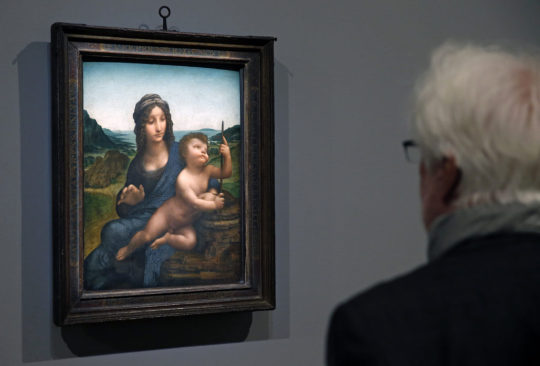
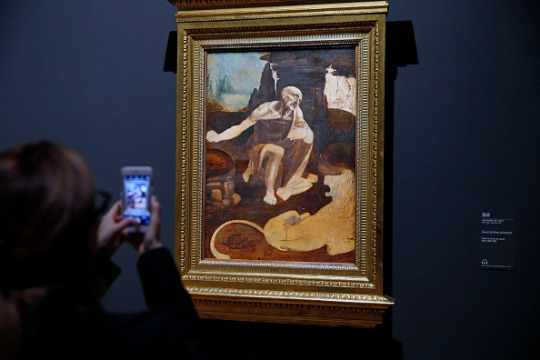
Scientists Identify Secret Ingredient in Leonardo da Vinci Paintings
"Old Masters" such as Leonardo da Vinci, Sandro Botticelli and Rembrandt may have used proteins, especially egg yolk, in their oil paintings, according to a new study.
Trace quantities of protein residue have long been detected in classic oil paintings, though they were often ascribed to contamination. A new study published Tuesday in the journal Nature Communications found the inclusion was likely intentional — and sheds light on the technical knowledge of the Old Masters, the most skilled European painters of the 16th, 17th, or early 18th century, and the way they prepared their paints.
Scientists confirm long held theory about what inspired Monet
"There are very few written sources about this and no scientific work has been done before to investigate the subject in such depth," said study author Ophélie Ranquet of the Institute of Mechanical Process Engineering and Mechanics at the Karlsruhe Institute of Technology in Germany, in a phone interview. "Our results show that even with a very small amount of egg yolk, you can achieve an amazing change of properties in the oil paint, demonstrating how it might have been beneficial for the artists."
Simply adding some egg yolk to their works, it turns out, could have long-lasting effects that went beyond just aesthetics.
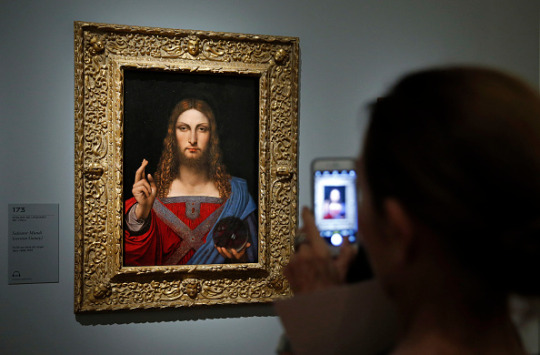

Eggs vs. oil
Compared with the medium formulated by ancient Egyptians called tempera — which combines egg yolk with powdered pigments and water — oil paint creates more intense colors, allows for very smooth color transitions and dries far less quickly, so it can be used for several days after its preparation. However, oil paint, which uses linseed or safflower oil instead of water, also has drawbacks, including being more susceptible to color darkening and damage caused by exposure to light.
Because making paint was an artisanal and experimental process, it is possible that the Old Masters might have added egg yolk, a familiar ingredient, to the newer type of paint, which first showed up in the seventh century in Central Asia before spreading to Northern Europe in the Middle Ages and Italy during the Renaissance. In the study, the researchers recreated the process of paint-making by using four ingredients — egg yolk, distilled water, linseed oil and pigment — to mix two historically popular and significant colors, lead white and ultramarine blue.
"The addition of egg yolk is beneficial because it can tune the properties of these paints in a drastic way," Ranquet said, "For example by showing aging differently: It takes a longer time for the paint to oxidize, because of the antioxidants contained in the yolk."
The chemical reactions between the oil, the pigment and the proteins in the yolk directly affect the paint's behavior and viscosity. "For example, the lead white pigment is quite sensitive to humidity, but if you coat it with a protein layer, it makes it a lot more resistant to it, making the paint quite easy to apply," Ranquet said.
"On the other hand, if you wanted something stiffer without having to add a lot of pigment, with a bit of egg yolk you can create a high impasto paint," she added, referring to a painting technique where the paint is laid out in a stroke thick enough that the brushstrokes are still visible. Using less pigment would have been desirable centuries ago, when certain pigments — such as lapis lazuli, which was used to make ultramarine blue — were more expensive than gold, according to Ranquet.

A direct evidence of the effect of egg yolk in oil paint, or lack thereof, can be seen in Leonardo da Vinci's "Madonna of the Carnation," one of the paintings observed during the study. Currently on display at the Alte Pinakothek in Munich, Germany, the work shows evident wrinkling on the face of Mary and the child.
"Oil paint starts to dry from the surface down, which is why it wrinkles," Ranquet said.
One reason for wrinkling may be an insufficient quantity of pigments in the paint, and the study has shown that this effect could be avoided with the addition of egg yolk: "That's quite amazing because you have the same quantity of pigment in your paint, but the presence of the egg yolk changes everything."
Because wrinkling occurs within days, it's likely that Leonardo and other Old Masters might have caught onto this particular effect, as well as additional beneficial properties of egg yolk in oil paint, including resistance to humidity. The "Madonna of Carnation" is one of Leonardo's earliest paintings, created at a time when he might have been still trying to master the then newly popular medium of oil paint.


New understanding of the classics
Another painting observed during the study was "The Lamentation Over the Dead Christ," by Botticelli, also on display at the Alte Pinakothek. The work is mostly made with tempera, but oil paint has been used for the background and some secondary elements.
"We knew that some parts of the paintings show brushstrokes that are typical for what we call an oil painting, and yet we detected the presence of proteins," Ranquet said. "Because it's a very small quantity and they are difficult to detect, this might be dismissed as contamination: In workshops, artists used many different things, and maybe the eggs were just from the tempera."
However, because adding egg yolk had such desirable effects on oil paint, the presence of proteins in the work might be an indication of deliberate use instead, the study suggested. Ranquet hopes that these preliminary findings might attract more curiosity toward this understudied topic.
Maria Perla Colombini, a professor of analytical chemistry at the University of Pisa in Italy, who was not involved in the study, agreed. "This exciting paper provides a new scenario for the understanding of old painting techniques," she said in an email.
"The research group, reporting results from molecular level up to a macroscopic scale, contributes to a new knowledge in the use of egg yolk and oil binders. They are not more looking at simply identifying the materials used by Old Masters but explain how they could produce wonderful and glittering effects by employing and mixing the few available natural materials. They try to discover the secrets of old recipes of which little or nothing is written," she added.
"This new knowledge contributes not only to a better conservation and preservation of artworks but also to a better comprehension of art history."

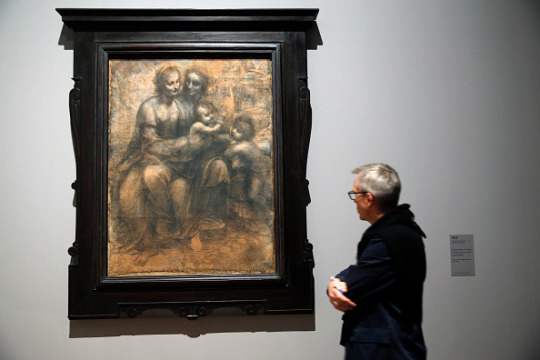
By Jacopo Prisco.
#Leonardo da Vinci#Scientists Identify Secret Ingredient in Leonardo da Vinci Paintings#italian artist#painter#painting#egg yolks#egg yolk in paintings#art#artist#art work#art world#art news#old masters
63 notes
·
View notes